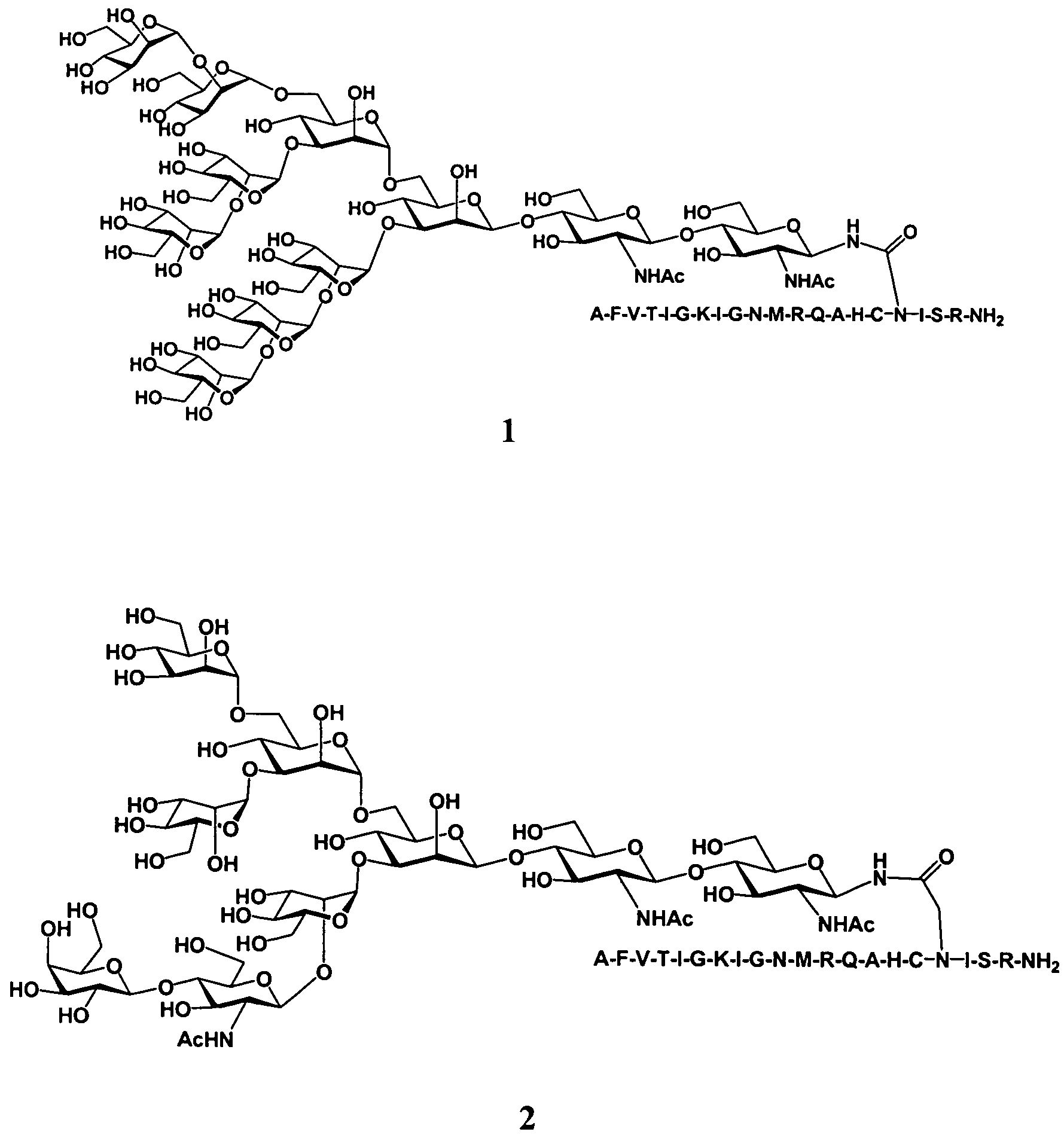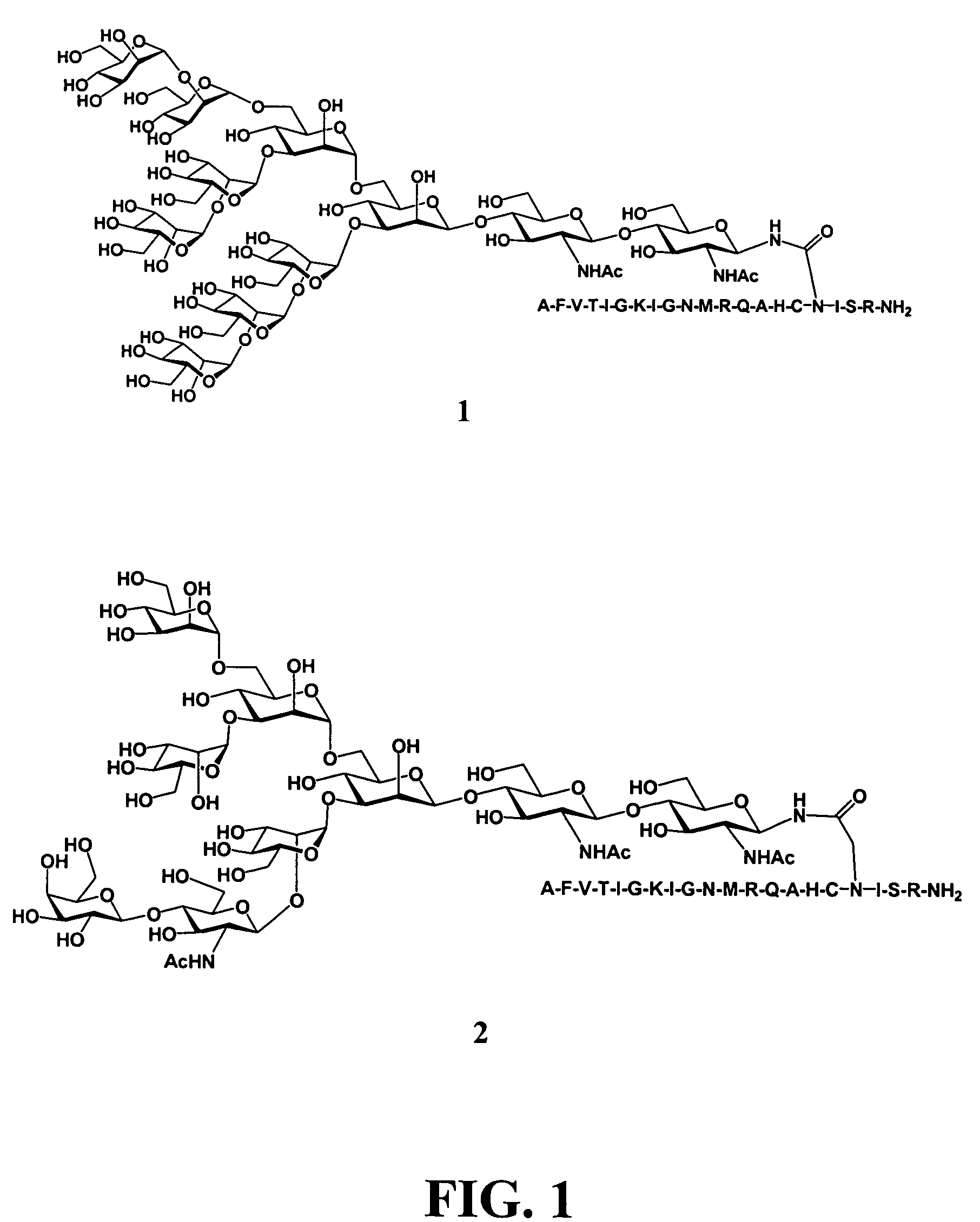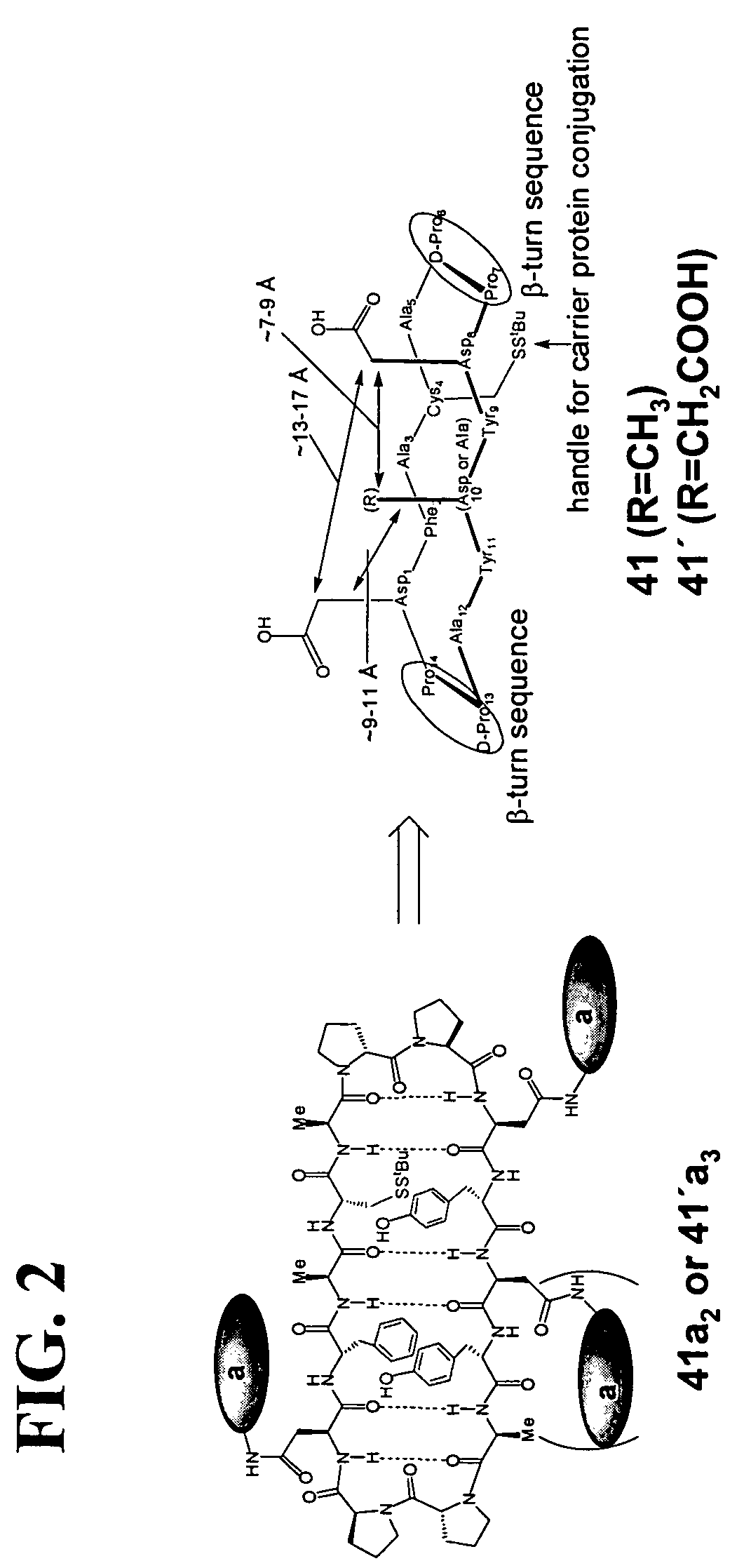Gp120 specific antigens and uses thereof
a specific antigen and gp120 technology, applied in the field of gp120 specific antigens, can solve the problems of low immunogenicity of the viral surface, unable to elicit a potent and broadly neutralizing antibody response, and commonly utilized vaccine formulations have been unable to achieve potent and broadly neutralizing antibody responses, so as to enhance the immunogenicity of the inventive gp120 compound, and enhance the immunogenicity of the immunogen
- Summary
- Abstract
- Description
- Claims
- Application Information
AI Technical Summary
Benefits of technology
Problems solved by technology
Method used
Image
Examples
example 1
[0631]
[0632]Tetrasaccharide 3: A mixture of trisacchride 11 (106 mg, 0.074 mmol), thiomannoside 2 (133 mg, 0.222 mmol) and molecular sieves in CH3CN (2 mL) was stirred for 2 h at r.t. and tris(4-bromophenyl)aminium hexachloroantimonate (199 mg, 0.244 mmol) was added at 15° C. The solution was stirred for 4 h at r.t. and then quenched by triethylamine. The mixture was filtered through celite, concentrated, dissolved in EtOAc, filtered through silica gel and concentrated. The residue was purified by preparative TLC (PTLC) using pentane / ether (1 / 2 ) as the eluent to afford 3 as a white solid (113 mg, 78%). [α]D25−205.0 (c 0.14, CHCl3). 1H NMR (400 MHz, CDCl3) selected signals: δ 0.00 (s, 3H), 0.06 (s, 3H), 0.87 (s, 9H), 5.07 (s, 1H), 5.30 (s, 1H), 5.36 (s, 1H), 5.74 (s, 3H). 13C NMR (100 MHz, CDCl3) δ−5.8, −4.6, 13.9, 17.8, 20.8, 25.6, 57.8, 58.6, 60.1, 66.8, 67.5, 67.8, 68.2, 68.4, 68.9, 69.5, 71.0, 72.3, 73.1, 73.3, 73.5, 73.9, 74.3, 74.9, 75.1, 75.3, 75.8, 77.3, 77.6, 77.9, 78.2, 79...
example 2
[0633]
[0634]Tetrasaccharide 4: To a solution of 3 (200 mg, 0.101 mmol) in borane tetrahydrofuran etherate (1.1 mL, 1.0 M in THF, 1.01 mmol) was added dibutylboron triflate (0.334 mL, 1.0 M in CH2Cl2, 0.333 mmol) at 0° C. The reaction mixture was stirred for 7 h at 0° C. and quenched with triethylamine and methanol and concentrated. The residue was purified by PTLC using pentane / ether (1 / 2) as the eluent to afford 4 as a white solid (172 mg, 90%). [α]D25 −187.0 (c 0.13, CHCl3). 1H NMR (400 MHz, CDCl3) selected signals: δ−0.08 (s, 3H), −0.04 (s, 3H), 0.80 (s, 9H), 4.96 (d, J=2.6 Hz, 1H), 5.15 (s, 1H), 5.55 (s, 1H). 13C NMR (100 MHz, CDCl3) δ−5.7, −4.6, 17.9, 25.7, 57.9, 58.3, 67.6, 68.9, 69.8, 71.3, 72.4, 73.2, 73.4, 73.9, 74.3, 74.5, 75.0, 76.0, 77.3, 78.1, 79.6, 79.9, 92.7, 99.3, 100.6, 101.0, 126.8-128.7, 129.8, 137.6, 137.7, 138.2, 138.3, 138.4, 140.5, 141.0, 165.2. LRMS (ESI) calcd for C112H124N2O24S2SiNa+ [M+Na]+ 1995.8, found 1995.8.
example 3
[0635]
[0636]Pentasaccharide 6: 6 was prepared using same procedure as the synthesis of 3. White solid (80 mg, 74%). [α]D25 51.0 (c 0.13, CHCl3). 1H NMR (400 MHz, CDCl3) selected signals: δ−0.07 (s, 3H), −0.02 (s, 3H), 0.80 (s, 9H), 4.95 (s, 1H), 4.99 (s, 1H), 5.25 (s, 1H), 5.54 (dd, J=9.5, 2.5 Hz, 1H), 5.58 (s, 1H). 13C NMR (100 MHz, CDCl3) δ−5.8, −4.6, 14.0, 17.9, 20.9, 22.5, 25.7, 31.4, 57.8, 58.6, 60.2, 67.7, 68.9, 69.6, 70.1, 71.5, 72.5, 72.9, 73.2, 73.9, 74.4, 74.8, 75.2, 75.9, 76.4, 77.3, 79.1, 92.7, 97.9, 99.4, 101.1, 126.9-129.5, 129.6, 137.3, 137.7, 138.2, 138.4, 141.1, 165.2, 165.5, 166.1. LRMS (ESI) calcd for C146H154N2O31S2SiNa+ [M+Na]+ 2546.0, found 2545.9.
PUM
| Property | Measurement | Unit |
|---|---|---|
| temperature | aaaaa | aaaaa |
| temperature | aaaaa | aaaaa |
| thickness | aaaaa | aaaaa |
Abstract
Description
Claims
Application Information
 Login to View More
Login to View More - R&D
- Intellectual Property
- Life Sciences
- Materials
- Tech Scout
- Unparalleled Data Quality
- Higher Quality Content
- 60% Fewer Hallucinations
Browse by: Latest US Patents, China's latest patents, Technical Efficacy Thesaurus, Application Domain, Technology Topic, Popular Technical Reports.
© 2025 PatSnap. All rights reserved.Legal|Privacy policy|Modern Slavery Act Transparency Statement|Sitemap|About US| Contact US: help@patsnap.com



